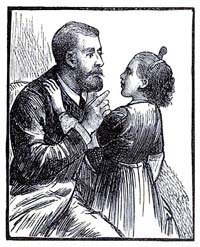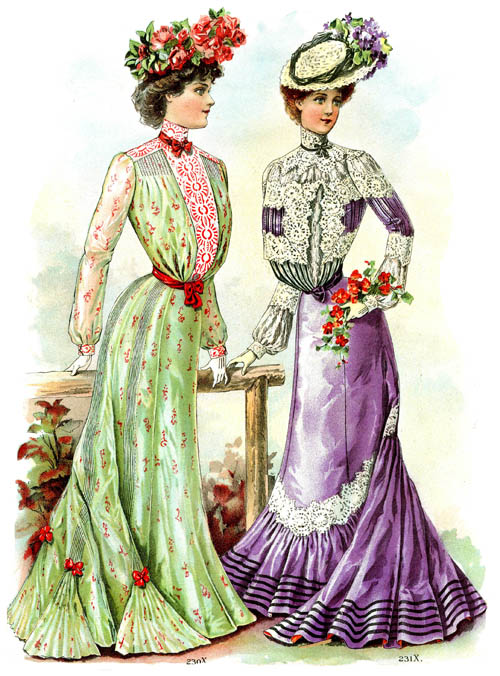|
Home > Victorian Health & Beauty > More Health Topics > Dealing with Disabilities

|
In the Victorian era, a person with a disability was considered "handicapped." Slowly the notion evolved that even a "handicapped" person - such as a blind person - could learn a trade that would enable him or her to be somewhat, if not completely, independent. Many of the schools that arose in the Victorian period to "help the blind" or "teach the deaf" were found on this principal. Interestingly, schools for the blind often found that music and singing were excellent avenues for their students. It's worth noting that sign language for the deaf and Braille for the blind were both 19th-century (actually pre-Victorian) developments.
|
- Anecdotes of the Deaf, Blind and Dumb
(Chambers Miscellany, 1845)
- Biographies of James Mitchell, Laura Bridgman (both deaf, blind and mute), and John Metcalf (blind), along with information on the current state of education and training for the blind.
- Books for the Blind
(Cassell's Family Paper, 1860)
- Several systems of embossed printing for the blind (but not including Braille).
- The Deaf and Dumb
(Cassell's Family Paper, 1860)
- Papers for Our Girl Sufferers, by Mary Selwood
(Girl's Own Paper, 1884)
- Tips for the blind, the deaf, "defective speakers and stammerers," and the lame.
- To the Deaf, by Katharine Armstrong
(Century Magazine, 1888A)
- "If people only knew how to talk to the deaf, a great many heart-aches would be saved. First, have a little consideration, and by a very trifling motion, which they readily see and understand, call their attention to you; then articulate clearly and distinctly - not too fast, and not too loud. It is this shouting into the ear of a deaf person that fills him with confusion..."
- Literature for the Blind, by Alice King
(Girl's Own Paper, 1889)
- On the establishment of a new circulating library of volumes in raised and Braille type.
- A Glimpse of Some Sightless Folk, by F.M. Holmes
(Quiver, 1889)
- Occupations held by blind workers.
- In Darkness and Silence
(Girl's Own Paper, 1890)
- Laura Bridgman, an American woman who was deaf, dumb, and blind.
- Bessie Gilbert, by Alice King
(Girl's Own Paper, 1892)
- "This blind woman...determined that...blind men and women should be enabled to take a reasonable, active place in the community, and to live by the work of their own brains or hands."
- The Prevention of Blindness in Infants, by Swan M. Burnett, MD
(Century Magazine, 1893A)
- A Tea-Party in the Height of the Season
(Girl's Own Paper, 1893)
- A tea-party given for handicapped children.
- Speech and Speech-Reading for the Deaf, by Edith Coues
(Century Magazine, 1897A)
- Deaf People, and How to Help Them, by Alfrey Porter
(Girl's Own Paper, 1898)
- Tips on teaching the art of lip-reading.
- The Remarkable Case of Miss [Fannie] Tunison
(The Strand, 1900A)
- An American quadriplegic who managed to earn a living by painting with her tongue.
- "Such as Sit in Darkness"
(Sunday Strand, 1902)
- A Visit to the National Christian Blind Relief Society.
-
|
Schools & Training Programs
|
- School for the Indigent Blind, Southwark
(Cassell's Family Paper, 1860)
- How the Blind Are Taught to Read, by W.W. Fenn
(Cassell's Family Magazine, 1879)
- Music for the Blind, by William H. Cummings
(Cassell's Family Magazine, 1880)
- An article by a Professor of Singing at the Royal Normal College for the Blind
- Out of the Silence
(Cassell's Family Magazine, 1882)
- Educating the deaf and dumb.
- Education of the Blind, by Edward B. Perry
(Century Magazine, 1887B)
- Higher Education for the Blind, by William Burnet
(Cassell's Family Magazine, 1887)
- The Royal Normal College and Academy of Music
- How the Blind Are Educated, by Edward Salmon
(The Strand, 1891A)
- A visit to the Royal Normal College for the Blind at Upper Norwood, where students are taught not only to read and write but to master a variety of trades.
- How the Deaf and Dumb Are Educated, by Edward Salmon
(The Strand, 1892A)
- Help for Deaf Girls
(Girl's Own Paper, 1897)
- Information on some societies and programs for the deaf and dumb.
- The Education of the Blind, by Philip Gibbs
(Windsor Magazine, 1900B)
- Deaf Girls Among the Vines
(Girl's Own Paper, 1902)
- A rare photo taken at the California Institution for the Blind and Deaf.
- See also
- • Education for Special Needs
- • People: Victorians with Disabilities
|
Visit Our Victorian Shop
for:
Books
Coloring Books
Beautiful Spiral Journals
Holiday Greeting Cards
|
|


 Discover thousands of Victorian images in our
Discover thousands of Victorian images in our 